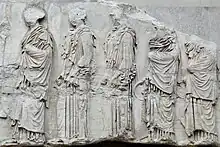_-_Google_Art_Project_-_edited.jpg.webp)
Architectural mythology means the symbolism in real-world architecture, as well as the architecture described in mythological stories.[1] In addition to language, a myth could be represented by a painting, a sculpture, or a building. It is about the overall story of an architectural work, often revealed through art.
Not all stories surrounding an architectural work incorporate a level of myth. These stories can also be well hidden from the casual viewer and are often built into the conceptual design of the architectural statement.
The value of a built environment, therefore, is a conglomerate of its actual physical existence and the historical memories and myths people attach to it, bring to it, and project on it.
— Oliver, P.[2]
Ancient Greek architecture
Before 600 BC worship was done in the open, but when the Greeks began to represent their Gods by large statues, it was necessary to provide a building for this purpose. This led to the development of temples.[3]

The ancient Greek temples were often enhanced with mythological decorations from the columns to the roof. The architectural functions of the temple mainly concentrated on the cella with the cult statue. The architectural elaboration served to stress the dignity of the cella.
The South, West, and North sides of the Parthenon frieze show a procession of human figures.[4] The East side contains Greek gods in various positions. The gods on the left side of the frieze tend to have stronger associations with the underworld while the gods on the right reside over spheres of fertility and optimism. This creates a story of life and death across the East Frieze.[4]
Ancient Egyptian Architecture

The great pyramids are an architectural feat constructed as a means to house the remains of ancient Egyptian rulers. Inscribed on the interior pyramid walls are hieroglyphic texts describing the afterlife and ancient Egyptian mythology.[5] There are as many as 900 individual compositions in each pyramid.[5]
The sphinx was a mythical creature with the body of a lion and head of a man wearing a pharaoh headdress. Sphinx statues were commonly found in or near ancient Egyptian temples and tombs. The sphinx was thought to be a guardian for the ancient rulers of Egypt.[6] These sphinxes like the pyramids had inscriptions on their bases and bodies. These inscriptions were references to the Egyptian gods such as Horus, Nekhbet, Wadjet and many others.[6]
Ancient Roman Architecture
_-_Interior_05.jpg.webp)
Many ancient Roman temples were constructed for religious purposes. The most influential example is the Pantheon. While there is very little surviving written information about the building historian Cassius Dio remarked:
Perhaps it has this name because, among the statues which embellished it, there were those of many gods, including Mars and Venus; but my own opinion on the origin of the name is that, because of its vaulted roof, it actually resembles the heavens[7].
See also
References
- ↑ W.R. Lethaby, 1892
- ↑ Oliver, P. (1993) In: O. Graber "Why History: the meanings and uses of tradition" – TDSR 4 (No. 2): 19
- ↑ Donald E. Strong, pp. 35-36
- 1 2 Sandin, Pär Ola (2022-12-31). "Life and Death on the East Frieze of the Parthenon". Symbolae Osloenses. 96 (1): 4–44. doi:10.1080/00397679.2023.2175502. ISSN 0039-7679.
- 1 2 Hays, Harold M. (2012), "Introduction", The Organization of the Pyramid Texts (2 vols.), Typology and Disposition, Brill, pp. 1–16, doi:10.1163/j.ctt1w76tzs.10, retrieved 2023-12-02
- 1 2 Wegner, Jennifer (2015). The Sphinx That Traveled to Philadelphia. University Museum Publications. pp. 193–237. ISBN 9781934536766.
- ↑ Hannah, Robert; Magli, Giulio (2011). "The Role of the Sun in the Pantheon's Design and Meaning". Numen. 58 (4): 486–513. ISSN 0029-5973.
Books
- Giedion, S.: The Beginnings of Architecture: The Eternal Present: A Contribution on Constancy and Change, New Jersey: Princeton University Press, 1981
- Lethaby, William Richard: Architecture, Mysticism and Myth Cosimo (first published 1892), English, 288 pages, ISBN 1-59605-380-1 (Online PDF)
- Mann, A.: Sacred Architecture, Shaftesbury: Element, 1993
- Donald E. Strong, The Classical World, Paul Hamlyn, London (1965)
External links
- Bruno Queysanne: Architecture and Mythology (Southern California Institute of Architecture: Media Archive)